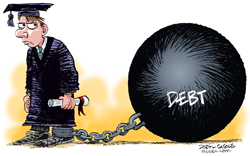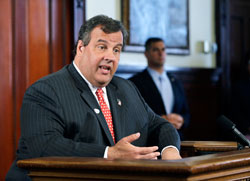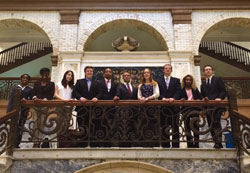Senator Elizabeth Warren’s “Bank on Students Emergency Loan Refinancing Act”, proposed in May 2014 was shot down. The bill sought to “allow most individuals with student loans (both federal and private) to refinance those loans into new federal direct loans at interest rates specified in the bill,” according to the Congressional Budget Office (CBO).
The proposal was voted down by Senate Republicans who claimed the bill was a political move, pitting students against the wealthy. This is because of the provision within the bill in which the drop in interest will be covered by the wealthiest Americans.
During summer 2013, Congress almost allowed the interest to double from 3.4 percent to 6.8 percent. The outcome was an interest rate fixed on a 10 year treasury note. This was seen as compromise by the parties, but did not begin to address the growing problem of student debt.
According to Businessweek, students who take out loans at 7.1 percent interest, owe in aggregate 1.2 trillion dollars, owing an average of 30,000 dollars each. The U.S. Government clears four billion dollars each year from student loans.
Private lenders, however, can raise interest rates as high as 20 percent. The picture is clearly a dismal one for college students as well as graduates. How could it get this bad for students, when there was a time an American could work his way through college?
According to mintpress.com, the student loan crisis has worked as a vicious cycle. When loans poured in for students, tuition cost was allowed to rise because of this easy money. More loans mean higher tuition to pay for more amenities. Additions are meant to attract more students and therefore more tuition dollars.
Claire Alasio, Director of Financial Aid, elaborated on the difference between financial aid at private and public institutions. Alasio said, “Public colleges and universities are subsidized by the state and, as a result, typically have tuition rates that are significantly lower than those found at private institutions. The lower tuition is the primary discount that the public schools make available to their students and there are little to no institutional scholarships. Private institutions usually charge more in tuition, but then offer students significant discounts in the form of grants and scholarships.”
This is evident, looking at the more than 500 percent tuition increase in both private and public schools since 1985, as reported by Bloomberg. At the same time the rise is five times higher than the consumer price index. So students take on more debt than ever, at higher interest rates and the job market has not been there to cushion that blow.
Paul Dement, Director of Community Relations and Government, said, “It does not appear likely that Senator Warren’s bill will be approved in the Senate and the House, under Republican leadership, [they] would not bring up a student refinancing bill paid for by increased taxes on the wealthy.”
He continued, “At this time, it appears that the best chance for this issue to be addressed is within the reauthorization of the Higher Education Act. The Higher Education Act is the major law that governs federal student aid, and in its initial inception, it increased federal money to universities, created scholarships and provided low-interest loans for students.”
However, Dement added, “The process of reauthorizing the Higher Education Act just began in June and could take a couple of years to be completed.”
According to US News, the University of Chicago has eliminated student loans for its incoming freshman class and beyond. Student loans will now be replaced by grants and a financial fund raised by the University of Chicago campaign. There are among 50 universities around the country that reduce or eliminate student loans. The pressure student loans have put on students and their families is immense, and the effect is evident.
Alasio said that the future for student loans is not easily discernable. She said, “As [interest] rates are influenced by the global economy and financial markets, it is impossible to predict whether they will decrease in the foreseeable future.”
For now, Monmouth students’ income-based repayment of federal loans allow graduates to pay only what they can, based on their income. The Obama Administration has implemented a plan which allows graduates who work for the government to have their loans relieved.
Mike Frisse, a senior business accounting and real estate major, was at a crossroads with the problem. “I guess the government does need a way to cover its bases with interest [when it comes to student debt]. But shouldn’t also education be a priority? Students are the future.” He said. “Look how Germany has free education now.”
IMAGE TAKEN from occupy.com




